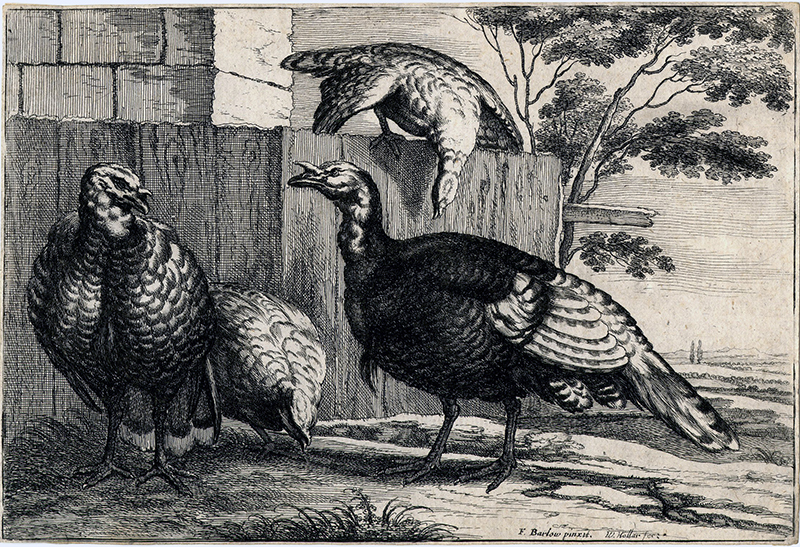
19th, 20th & 21st Century Fine Prints
707-546-7352 · fax 707-546-7924 · web: www.annexgalleries.com · email: artannex@aol.com
Four Turkeys by a Fence (after Francis Barlow) from 'Diversae Avium Species' by Wenceslaus Hollar

Four Turkeys by a Fence (after Francis Barlow) from 'Diversae Avium Species'
Wenceslaus Hollar
Four Turkeys by a Fence (after Francis Barlow) from 'Diversae Avium Species'
Wenceslaus Hollar
1607 - 1677 (biography)This etching of four turkeys was done by Wenceslaus Hollar between 1654 and 1658. It is etched after a drawing and etching by the British painter Francis Barlow and published in 1658 in "Diversae avium species studiosissime ad vitam delineatae per Fra: Barlow insignissim[um] Anglum pictorem." This impression is from the first state of two, before the top and bottom corner borders are joined. There is an impression of this state in the British Museum.
The turkey is native to North America and was introduced into Europe by the Spanish in the early 16th century, around a century before this image was done. The story about Benjamin Franklin wanting the National Bird to be a turkey is just a myth. This false story began as a result of a letter Franklin wrote to his daughter criticizing the original eagle design for the Great Seal, saying that it looked more like a turkey.
The Tate Museum in London comments on Barlow's earlier work, which is in reverse of Hollar's: "Barlow was the first native-born artist of animal and sporting subjects, and the first professional English book illustrator and etcher. Although his work was not confined to interpretations of the natural world, drawings of birds, animals and sporting scenes were undoubtedly his speciality. The turkeys shown here were sketched from life and, unusual for the time, are depicted in their natural habitat. Most of Barlow's drawings are related to printmaking, and the heavy outlining visible here would have been an aide in the process of transferring the image to a copper plate. 'Turkeys' is one of a group of drawings which would have been published together as a series illustrating birds of different species."
Almost complete collections of Hollar's work are kept in the British Museum, the print room at Windsor Castle and the National Gallery in Prague. Hollar's oeuvre was first catalogued in 1745 (2nd ed. 1759) by George Vertue. The prints were subsequently catalogued in 1853 by Gustav Parthey and in 1982 by Richard Pennington. A new complete illustrated catalogue has been published in the New Hollstein German series. Much of his work is available online from the University of Toronto. The Folger Shakespeare Library also holds some 2000 prints, drawings and other works by Hollar.
